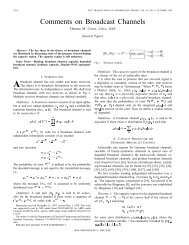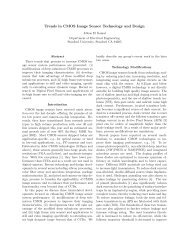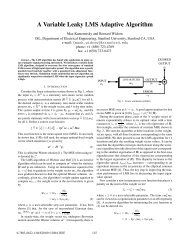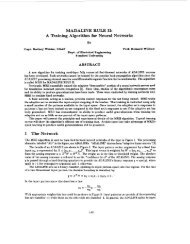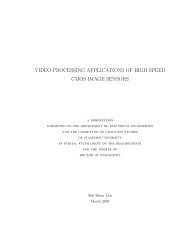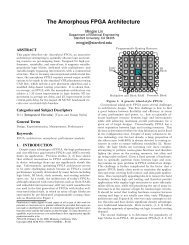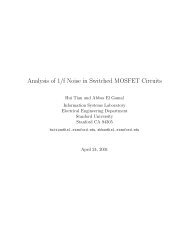A Graduate Level Course on Image Sensors and Digital Cameras
A Graduate Level Course on Image Sensors and Digital Cameras
A Graduate Level Course on Image Sensors and Digital Cameras
Create successful ePaper yourself
Turn your PDF publications into a flip-book with our unique Google optimized e-Paper software.
7. Color Processing: color demosaicing, color correcti<strong>on</strong><strong>and</strong> white balance.8. Analysis of digital camera signal path, from the scenethrough the imaging optics, the sensor, the A/D c<strong>on</strong>verter,to the different color processing steps using vCam, a MAT-LAB based digital camera simulator.9. Recent research topics, e.g., digital pixel sensor <strong>and</strong> highdynamic range schemes.4. DIGITAL CAMERA SIMULATORA digital camera, as depicted in Figure 1, is a complex systemcomprising comp<strong>on</strong>ents that use different technologies.Given the complexity of the system, simulati<strong>on</strong> tools areneeded to study any design tradeoffs <strong>and</strong> their ultimate effects<strong>on</strong> image quality. To the best of our knowledge nosuch simulati<strong>on</strong> tools are commercially available. To adressthis need, we developed our own camera simulator (vCam).Figure 2 shows vCam’s imaging pipeline. The simulatorprovides models for the scene, the imaging optics, <strong>and</strong> thesensor. The simulator is written in MATLAB <strong>and</strong> is modularto facilitate future modificati<strong>on</strong>s <strong>and</strong> extensi<strong>on</strong>s.LensCFA<strong>Image</strong>sensorAGCADCAutoFocusAutoExposureColorProcessing<strong>Image</strong>Enhancement&Compressi<strong>on</strong>C<strong>on</strong>trol &InterfaceFig. 1. Block diagram for a typical digital camera systemstudents resulting in a number of research publicati<strong>on</strong>s. Thefollowing are brief descripti<strong>on</strong>s of the most recent projects.5.1. Pixel size studyAn important parameter in the design of an image sensoris the choice of pixel size. A small pixel size is desirablebecause it results in a smaller die size <strong>and</strong>/or higher spatialresoluti<strong>on</strong>, while a large pixel size is desirable because it resultsin higher dynamic range <strong>and</strong> signal-to-noise ratio. Weasked the students to investigate this tradeoff analytically<strong>and</strong> using vCam. This project was pursued further resultingin a c<strong>on</strong>ference paper [2].5.2. High dynamic range schemesAn important figure of merit for image sensors is dynamicrange, i.e., the range of illuminati<strong>on</strong> that can be captured ina single image. Several schemes have been proposed to enhanceCMOS image sensor dynamic range. The purposeof this project was to compare the performance of theseschemes based <strong>on</strong> SNR <strong>and</strong> image quality using vCam. Theprojects c<strong>on</strong>firmed the results of the h<strong>and</strong> analysis in [3].5.3. “H<strong>on</strong>ey Comb” pixel arrayFuji Film recently introduced a new CCD image sensor [4],which they called “H<strong>on</strong>ey Comb” CCD. The main motivati<strong>on</strong>for this structure is to enhance spatial resoluti<strong>on</strong> withoutincreasing the number of pixels or die size (cost). Thegoal of this project was to use vCam to validate (or dispute)the claimed advantage of the “H<strong>on</strong>ey Comb” array structureover the c<strong>on</strong>venti<strong>on</strong>al rectangular pixel array. The projectshave shown that for scenes with mainly vertical <strong>and</strong> horiz<strong>on</strong>talspatial structures, the “H<strong>on</strong>ey Comb” pattern is indeedbetter. No advantage was observed for other types ofscenes.6. REFERENCES[1] “Introducti<strong>on</strong> to <strong>Image</strong> <strong>Sensors</strong> <strong>and</strong> <strong>Digital</strong> <strong>Cameras</strong>,”in http://www.stanford.edu/class/ee392b.[2] T. Chen, P.B. Catrysse, A. El Gamal, <strong>and</strong> B.A. W<strong>and</strong>ell,“How small should pixel size be?,” in Proceedings ofSPIE, April 2000, vol. 3965, pp. 451–459.Fig. 2. vCam imaging pipeline5. SAMPLE COURSE PROJECTSAn important requirement for the course is the final classproject. Each year we proposed <strong>on</strong>e or two projects that thestudents did in pairs. Most projects required the studentsto use vCam as a tool for optimizing or comparing designopti<strong>on</strong>s. Several projects have been pursued further by the[3] D.X.D Yang <strong>and</strong> A. El Gamal, “Comparative analysisof SNR for image sensors with widened dynamicrange,” in Proceedings of SPIE, February 1999, vol.3650, pp. 22–28.[4] T. Yamada, Y.G. Kim, H. Wakoh, T. Toma,T. Sakamoto, K. Ogawa, <strong>and</strong> E. Okamoto, “A ProgressiveScan CCD <strong>Image</strong>r for DSC Applicati<strong>on</strong>s,” 2000IEEE ISSCC Digest of Technical Papers, vol. 43, pp.110–111, February 2000.



